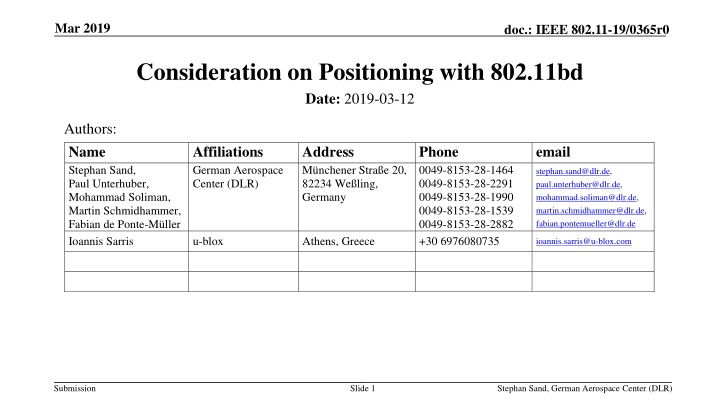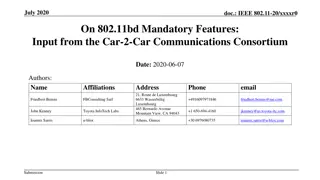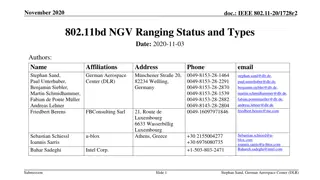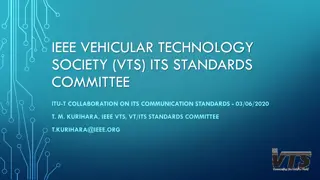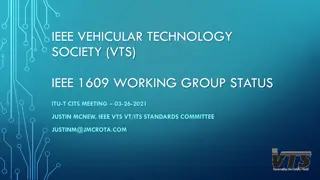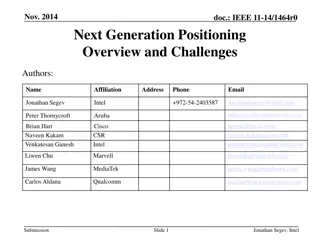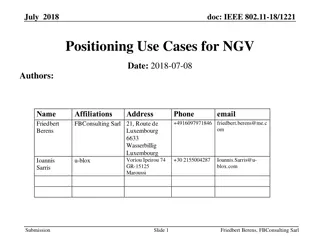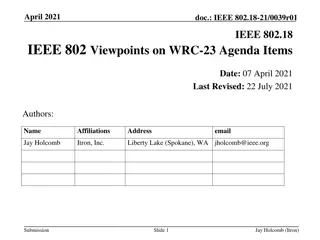Positioning Considerations in IEEE 802.11bd for Vehicular Communication
Discussing the implications of IEEE 802.11mc and 802.11az improvements on Fine Timing Measurement (FTM) protocol for positioning in high mobility environments, particularly focusing on V2X communications and vehicle speeds up to 250 km/h. The document addresses positioning modes, interoperability, coexistence, and backward compatibility with existing devices. Various use cases such as Vehicular Positioning & Location, Train-to-Train, and Vehicle-to-Train are explored.
Download Presentation

Please find below an Image/Link to download the presentation.
The content on the website is provided AS IS for your information and personal use only. It may not be sold, licensed, or shared on other websites without obtaining consent from the author.If you encounter any issues during the download, it is possible that the publisher has removed the file from their server.
You are allowed to download the files provided on this website for personal or commercial use, subject to the condition that they are used lawfully. All files are the property of their respective owners.
The content on the website is provided AS IS for your information and personal use only. It may not be sold, licensed, or shared on other websites without obtaining consent from the author.
E N D
Presentation Transcript
Mar 2019 doc.: IEEE 802.11-19/0365r0 Consideration on Positioning with 802.11bd Date: 2019-03-12 Authors: Name Stephan Sand, Paul Unterhuber, Mohammad Soliman, Martin Schmidhammer, Fabian de Ponte-M ller Ioannis Sarris Affiliations German Aerospace Center (DLR) Address M nchener Stra e 20, 82234 We ling, Germany Phone 0049-8153-28-1464 0049-8153-28-2291 0049-8153-28-1990 0049-8153-28-1539 0049-8153-28-2882 +30 6976080735 email stephan.sand@dlr.de, paul.unterhuber@dlr.de, mohammad.soliman@dlr.de, martin.schmidhammer@dlr.de, fabian.pontemueller@dlr.de u-blox Athens, Greece ioannis.sarris@u-blox.com Submission Slide 1 Stephan Sand, German Aerospace Center (DLR)
Mar 2019 doc.: IEEE 802.11-19/0365r0 Abstract 802.11mc contains Fine Timing Measurement (FTM) Protocol for round trip ranging and positioning. 802.11az proposes some improvements on FTM such as NDP SU/MU ranging, trigger based ranging, AOA/AOD measurements, What are the implications for 802.11bd positioning mode? This is a discussion document so feedback highly welcome. Submission Slide 2 Stephan Sand, German Aerospace Center (DLR)
Mar 2019 doc.: IEEE 802.11-19/0365r0 Introduction PAR [1]: This amendment defines at least one mode that achieves at least 2 times higher throughput in high mobility channel environments at vehicle speeds up to 250 km/h (closing speeds up to 500 km/h); this amendment defines procedures for at least one form of positioning in conjunction with V2X communications This amendment shall provide interoperability, coexistence, backward compatibility, and fairness with deployed OCB (Outside the Context of a BSS) devices. Use Case (UC) baseline document [2]: UC5 Vehicular Positioning & Location UC8 Train-to-Train UC9 Vehicle-to-Train Submission Slide 3 Stephan Sand, German Aerospace Center (DLR)
Mar 2019 doc.: IEEE 802.11-19/0365r0 Current Situation V2X Proprietary solution [3] with road side units (RSUs) exists RSUs generally broadcast their position information in either, Wave Service Announcements (WSA) (IEEE 1609) Geonetworking messages (ETSI ITS) Ranging measurements Enhanced signal processing algorithms to improve robustness with regard to multipath effects achieve range accuracy in the order of nanoseconds Time-of-flight even in multipath channels RSUs honor SIFS timing: IEEE 802.11 devices should respond to Unicast packets with a short ACK at a very specific period of time after receipt of Unicast packet. 32 s@10 MHz Submission Slide 4 Stephan Sand, German Aerospace Center (DLR)
Mar 2019 doc.: IEEE 802.11-19/0365r0 Fine Timing Measurement (FTM) Protocol According to [4] FTM Time to obtain range ~ 30 ms Position: 3 ranges needed 100 120 ms 50 km/h=13.9 m/s 0.4m moved while obtaining one range 1.4m - 1.7m moved while obtaining three ranges ACK on FTM Measurement: aSIFSTime (32 s@10 MHz) Default accuracy 1.3 s 390m error 0.1% error (1/3 of sample) 10m error Submission Slide 5 Stephan Sand, German Aerospace Center (DLR)
Mar 2019 doc.: IEEE 802.11-19/0365r0 Discussion 5.9 GHz mode: V2X (X=V,I,P,T) ranging? Limits of round-trip ranging for high mobility? One way ranging useful? Multi-antenna approaches? Bandwidth and aSIFSTime? 802.11az features [5]? Quality indicators for higher layer(data fusion: Channel impulse response, clock parameters, etc.? Can we reuse existing messages or do we need dedicated 11bd ranging message? Simulation and channel models [6]? 60 GHz mode: ranging mode (large bandwidth high ranging accuracy)? Submission Slide 6 Stephan Sand, German Aerospace Center (DLR)
Mar 2019 doc.: IEEE 802.11-19/0365r0 References [1] TGbd, Project Authorization Request (PAR) , IEEE 802.11-18/0861r9 [2] NGV SG, Use Case Baseline Document Approved By SG , IEEE 802.11- 18/1323r2 [3] Cohda Wireless, V2X-Locate Positioning Whitepaper , https://cohdawireless.com/wp-content/uploads/2018/08/Whitepaper_V2X- Locate.pdf [4] L. Banin, et al., High-Accuracy Indoor Geolocation using Collaborative Time of Arrival (CToA) - Whitepaper , IEEE 802.11-17/1387r0 [5] L. Chu, et al., NGV Ranging Discussion , IEEE 802.11-18/1250r0 [6] P. Unterhuber, et al., Considerations on Vehicular Channel Models , IEEE 802.11-19/0034r1 Slide 7 Submission Stephan Sand, German Aerospace Center (DLR)
